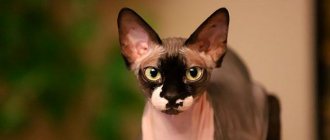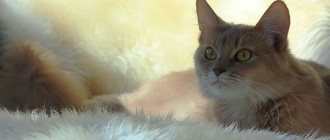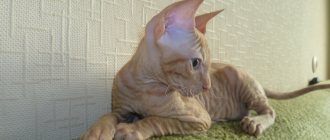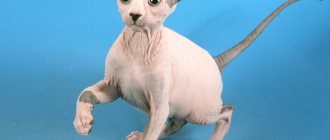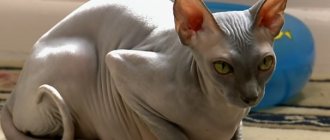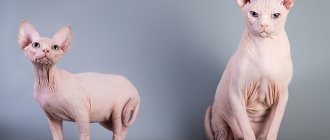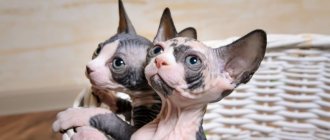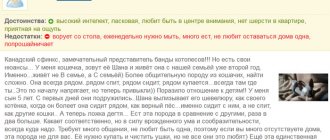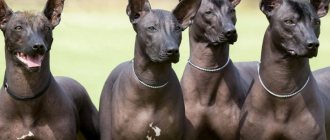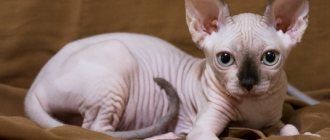Nowadays cats with a lack of hair will not surprise anyone. The current varieties of sphinxes evoke a smile, curiosity and a desire to touch the delicate skin of a hairless cat. But just twenty years ago, this breed evoked a mixture of horror and admiration.
Graceful animals with a mysterious look instantly captivated cat connoisseurs, and a boom swept across the planet, leading to the development of selective breeding. Attempts to breed a new species led to unexpected results.
By the way, these luxurious beauties are usually called not bald, but naked. Friendly pets with an exotic appearance have a good-natured character and an advantageous feature for people suffering from allergies is the lack of thick fur.
Features and habits of the Sphynx Brush cat
Cats without hair are no longer considered a novelty, and it is no longer possible to surprise with them. Modern breeds of such cats make many people smile and want to touch their skin and stroke them. The Sphynx Brush is a cat with little fur on its body - the hair is short and sparse, more like fluff.
Don Sphynx brush.
What does the Don Sphynx look like?
After looking at the photo of the Don Sphynx, one gets the impression that he has a lot in common with Egyptian cats. The size of representatives of this breed reaches 25-30 cm in height at the withers. How much a Donchak should weigh depends on gender - boys are always larger. They reach 5-7 kg. The weight of girls is more modest and amounts to 3.5-5 kg.
Muzzle
The breed is characterized by a wedge-shaped head with pronounced cheekbones and a strong-willed chin. On the rounded muzzle there is a straight nose, connected to the wrinkled forehead by a pronounced stop. On the top of the head are large, widely set ears, rounded at the tips.
The Donchak has slightly slanted, almond-shaped eyes that lack eyelashes. Short vibrissae are twisted into a spiral. They often break off, and sometimes they don’t grow back at all. Defects of the breed include a narrow or rounded head, too small ears, inversion of the eyelids and an underbite of more than 2 mm.
Body type
The low and thin neck goes into a dense and muscular body, expanding in the croup and chest. The front limbs of the Doncha are shorter than the hind limbs. They end in strong and powerful paws with elongated toes. The flexible, whip-like tail tapers to a tip. An abundance of folds is characteristic of the neck, armpits, paws, abdomen, groin area and tail.
Skin and color
The elastic skin of the Don people is completely bald or covered with soft down. Depending on the type and structure of the existing fur, there are 4 varieties of the Don Sphynx:
- Brush
. The most unusual species with sparse curly fur. The length of its hairs is the maximum. Such animals are not allowed for exhibitions, but are used for breeding. With age, the number of curly hairs decreases. - Flock
. The body is covered with “peach fuzz”, which gradually disappears. - Velor
. Unlike flocks, the fluff of a velor cat is longer and thicker. It also disappears as they grow older, but sometimes the coarsest hairs remain on the head and paws. - Hollowborn
. The fur is completely absent. The skin is covered with many wrinkles and is slightly sticky to the touch due to a special secretion. It is secreted by the sebaceous glands to protect against infections.
Among the colors of the Don Sphynx, any colors are allowed except lilac and chocolate. Due to the lack of fur, these cats rarely cause allergies in people.
Skin and coat types of sphinxes
Only 4 types of sphinxes fit the description of hairless cats. The first of these to appear were representatives of the Canadian breed, whose targeted selection began in 1960. Although the name of these sphinxes cemented their affiliation with the Country of the Maple Leaf, the main experiments were carried out in the United States.
The mutation that led to the hair loss occurred naturally for unknown reasons. The Canadian Sphynx is born with fur, and then carries residual signs of it throughout its life. He only looks completely naked from afar. In fact, the thick skin is covered with fluff (up to 2 mm), and there is short hair on the bridge of the nose. Hair growth is also allowed on the inside of the ears, between the toes, on the belly and tail. To the touch, the skin of the Canadian Sphynx gives the impression of velor or velvet pile - an almost imperceptible gentle coating.
“Canadians” are born in this form and no significant transformations occur to them throughout their lives.
Another branch is the Don Sphynx, which was bred in Russia 20 years later. The hairlessness of this breed is due to a mutation of completely different genes and, although externally similar to the Canadian Sphynx, the domestic species has significant differences:
- there are Don Sphynxes with fur;
- As cats of this breed grow older, their external signs change.
Important! It is by the condition of the skin and the presence of overgrowth that experts can distinguish between these groups of cats. Moreover, this applies to all representatives, which also include Ukrainian Levkoys and Peterbalds (St. Petersburg sphinxes).
Hulborn
Such sphinxes have had no hair since childhood. Kittens of the Canadian breed may also have this sign, but later the body becomes covered with fluff. And the Don remain naked for the rest of their lives.
Naked with whiskers and eyebrows
The second type of naked-born. They can be born with no facial hair at all, or they can have mustaches and eyebrows. This sign is typical only for this group, and in all other cases, “woolen” sphinxes demonstrate all the signs that are provided for in the breed standard.
Flock
Rare wool that fits very tightly to the body. From a distance it is not even visible, but from a close distance it becomes noticeable. The faint fluffy coating on the skin feels like a delicate red dusting, like on peach fruits. Flock cats are often called velor cats, although in fact they are two different groups.
Sphinx velor
Externally, velor Sphynx cats are very similar to flock cats, but upon closer inspection and to the touch they are completely different. The fur of velor sphinxes is longer and thicker, but it lies tightly on the body and is therefore not visible at all. Depending on the color, this visual illusion behaves differently. The black velor Sphynx seems completely naked, but if you run your finger against the fur, you can feel the obvious resistance of the hair.
Soft brush
The description of the appearance of the Sphynx Brush breed may vary depending on which animal is in mind. The coat of Sphynx cats from this group is soft and slightly wavy.
Hard brush
The second group in the description of brush sphinxes has more elastic and springy hair. It curls and looks like lamb's wool. Grows longer than the coat of a soft brush.
Straight-haired
There are also very unusual sphinxes with fur. In terms of the quality of their coat, they are very similar to shorthaired cats. This species lingered in the group of hairless cats for the only reason - experts still haven’t figured out the mechanics of genetic mutation. Overgrown Sphynx cats with fur carry a mixed “cocktail” of traits that in the next generations can give rise to full-fledged rubber, flock, velor or brush kittens.
pros
Many owners note the friendly and easy-going nature of Sphynx cats with fur. Cats of this breed have the following advantages:
- lack of aggression;
- high intelligence;
- learning ability;
- good harmony with other species of animals;
- pickiness in food;
- cleanliness.
In addition, Sphynx cats with fur are considered healing cats. They have increased heat exchange, and the surface of the hair always remains hot. These animals can be used as living heating pads. They are extremely affectionate and love to cuddle up to the human body.
Straight-haired
The basis of the species is the selection of Siamese and Oriental cats with Sphynxes. These animals do not have the baldness gene; they have normal fur and mustaches. The coat is short, close to the body, of the oriental type. The color of the Peterbald often repeats the color of its ancestors - the Siamese and Oriental groups.
Flock
Newborn kittens may appear hairless. But upon closer examination, you can notice sparse hairs no more than 2 mm long on the skin. The Sphynx flock has wool that resembles velvet in its structure. It covers the entire body of the animal.
The short coat persists only in childhood and young adulthood. As the animal grows, the hairs gradually become thinner and then disappear altogether. By about 2 years of age, cats become completely hairless.
Knitting features
Before breeding Sphynxes, it is necessary to take into account that completely hairless cats cannot be mated with the same cats. As a result of such a union, offspring with various pathologies may appear. Ideally, one of the parents will be bald, and the other will have brush or velor.
The cat should go on a “date”. Ideal for mating are individuals who have already gone through two heats - this is approximately one and a half years old. A sign for a cat to visit is the animal's excessive affection - the cat rubs against everything, and when you stroke its back, it purrs, arches and trembles. A cat will help you figure out exactly whether he is ready for mating - if the kitty arrived on time, he will immediately show his readiness for affection, filling the room with a loud cry. If the time has not yet come, the cat may leave altogether. A guaranteed result can be achieved only after several matings.
Velours
Velor cats have longer and fuller coats than flocked cats. The Velor Sphynx is born with velvet hair that is clearly visible to the touch. The length of the villi can reach up to 3 mm. Velor Peterbalds have longer hair on their paws, face and tail than on other parts of the body.
With age, hair follicles die off. Velor Don Sphynxes completely lose their hair. In adulthood, these cats appear completely hairless. Adult Peterbalds may still have remnants of hair on their paws and head.
At what month does a Sphynx cat lose all its hair?
Currently, there are three intra-breed varieties: barebred (rubber), velor “flocked” (with rudimentary hairs all over the body) and “brush” (with thick wavy and very soft hair or with hard, crimped, almost broken hair). One litter can produce both bare-born and “brush” kittens and velor kittens. If at birth a bald spot (“tonsure”) appears on the crown of the kittens of the last two types, then over time these kittens will shed their hair and turn into true sphinxes. How quickly this will happen can be determined at the age of 1-2 months. If the coat remains fine and silky at this age, the kitten will “undress” at about 4-5 months. If the coat is harsh to the touch, shedding the coat can take up to 1.5-2 years. However, the process of “undressing” is individual for each animal.
Naked and velor varieties of Don Sphynxes compete for titles and are successfully exhibited at various exhibitions. Brushes may be exhibited without the right to receive titles. At the same time, they are very actively used in breeding, especially when paired with naked-born. Some “brushes”, after reaching puberty, begin to intensively shed their hair and become completely hairless, with the exception of the limbs, on which short, soft and slightly wavy hair remains. Such animals can also be exhibited at exhibitions, they receive titles.
Canadian Sphynx
This cat breed is never completely naked. Sphynx kittens are not born hairless. Their hairline resembles suede. In adulthood, hair remains on the nose, behind the ears, as well as on the paws and tail. It looks like thin twisted fibers. The Canadian Sphynxes have all of the above varieties of coat.
conclusions
Is it worth buying a Sphynx kitten covered with fur? It depends on the purpose of purchasing the animal. If you are planning to take your pet to exhibitions, it is better to opt for hairless cat varieties. Animals with fur may not be allowed to exhibit. However, most hairy breeds (except straight-haired) can be bred for breeding and produce hairless offspring. In addition, Sphynx cats with fur can make wonderful pets. They are distinguished by their lack of aggression, goodwill and affection.
Differences between the Canadian and Don Sphynx
Cats without fur, with a lot of folds, look like aliens. They are all called Sphynxes, and not everyone knows that this breed has its own species that differ from each other. Canadian and Don Sphynxes have the following differences:
- species have different baldness genes (dominant and recessive);
- Canadian Sphynxes are always covered with barely noticeable fluff, and Don Sphynxes can be completely hairless (“rubber”);
- Canadian individuals are endowed with large round eyes, while Don individuals have an almond-shaped eye shape;
- Canadians have no mustache at all;
- in the Don species, the tail is of medium length and thickness, straight and rather strong, in contrast to the Canadians, whose tail is weak, thin and pointed at the end;
- Don individuals have a strong torso and a strong muscular system, in contrast to the underdeveloped muscles of Canadians.
How to choose the right kitten
Little Don Sphynxes are fragile and gentle creatures. They are susceptible to various diseases and often die at the age of several weeks. In order not to lose a newly adopted pet, it is advisable to purchase a kitten of this breed no earlier than he is 3 months old.
It is better to buy a Donchak from a specialized nursery or from a trusted breeder. At the time of sale, the Sphynx must have a veterinary passport with vaccination marks and a metric that confirms purebred.
Popular articles The unifying diversity of outbred cats
A healthy kitten has a neat appearance and is actively interested in everything that happens around it.
It is important that he does not have a bloated belly, watery eyes, dirt under his tail, scratched or flaky skin
Kitten care
Little Don Sphynx cats are taken from their mother at the age of 12 weeks. By this time, the kittens are already quite independent. They know how to eat, know the scratching post and are litter box trained. Therefore, new Donchak owners just need to give the pet time to get used to the changed conditions and show him places where he can eat, drink, go to the toilet and sharpen his claws.
For safety reasons, wires, indoor plants, household chemicals and small objects are hidden from the baby Sphynx. A curious kitten can climb into the most unexpected places. Therefore, before turning on the washing machine or oven, you should definitely look inside to make sure that there is no curious animal there.
Rules of care
These cats do not need serious care:
- Sphynx Brush cats are fed natural or premium dry food. Also, the cat’s body constantly needs a large amount of fluid and properly selected vitamins.
- Don't forget that the Sphynx Brush's ears and teeth need regular cleaning. Optimally - once a week.
- Brush cats need to be bathed regularly. You can buy a special product or take a good baby shampoo.
- Cats don't have eyelashes, so pay attention to their eyes. This is especially true for kittens - it is better to wipe their eyes with a damp, clean swab once a day.
Important! The hair of a plush Sphynx can change due to a new diet, temperature, humidity in the room, changes in hormonal levels during gestation or estrus.
Health
- Sphynx cats are prone to overeating
, so obesity can develop. The right approach to nutrition and choice of food will solve this problem. - Skin diseases
(dermatitis, acne, etc.). The skin secretion is constantly produced by the sebaceous and sweat glands. In poor conditions, an infection may develop on the skin and inflammation may develop. The solution is quite simple: regular skin care for the Sphynx, bathing, and cleaning the ears. - Respiratory infections.
Hypothermia, especially when the kitten is old, can cause a respiratory infection that will require veterinary treatment. Proper maintenance, care, and absence of drafts will prevent such conditions. Adult Sphynx cats rarely suffer from respiratory infections due to their high body temperature, which is detrimental to viruses.
Skin care and bathing
The Sphynx breed, due to its physiological characteristics, needs more frequent bathing than their furry counterparts. This procedure must be done correctly so that the cat does not experience stress and avoid health problems. It is better to do this in a shallow container or bath; the depth of the water should not exceed 15 cm. Cats are often frightened by the stream of flowing water.
It is recommended to use special care formulations or products for children as shampoo. They do not contain harsh ingredients that can cause irritation, and this breed has very sensitive skin.
Sphynx dogs have a high temperature, so they need to be washed with preheated water. The optimal temperature should be 36-39 degrees. When washing an animal, you need to calmly talk to it and stroke it so that the animal remains calm and does not get nervous. The amount of shampoo depends on the degree of soiling of the cat.
Table describing care procedures for Sphynx cats.
In some cases, you can do without it altogether by simply bathing it in warm water. When bathing, water should not get into the animal's ears, as this can lead to inflammatory processes. In this case, it is not recommended to wash your hair at all; you can use wet wipes.
It is not recommended to wash kittens that have recently been given a new home and have not yet had time to adapt to their new living conditions. The Sphynx should be bathed at least once every ten days. After bathing, the animal should be thoroughly dried and the room should be warm. Otherwise, the cat may catch a cold.
Sphynx kitten at six months.
Reviews
All owners of such tailed animals are very happy with them, it is impossible not to fall in love with them; as a rule, such pets become loved by all family members, even if someone is initially put off by their appearance. Cats of this variety are disciplined, easy to train and raise, and love to be photographed.
They are loyal and love their owners, meeting them at the doorstep and following them around the house everywhere. They often sleep in bed with people, love to purr on their knees and sleep in the warmth of human hugs.
To read: The regal Russian blue cat: the character and maintenance of a pet
Some take in adult animals, and they still quickly adapt to the new environment. They love children and easily find a common language with other representatives of the animal world. They do not spoil wallpaper and furniture, especially if you accustom them to scratching posts from childhood. They always go to the toilet in the litter box. The only thing that can be a problem for busy people is daily wiping, but for those who are already used to it, caring for a cat is a pleasure.
Character and special habits of brushes
These cats can be characterized as playful and inquisitive. Over time, they become full-fledged members of the family. They choose one master or favorite for themselves, they always obey him unquestioningly, carrying out all his commands. They treat other people with warmth and good nature. Also, the Sphynx Brush is intelligent, but tends to be touchy. However, he is not vindictive. You should not punish this animal physically and psychologically.
Brushes can be called empaths, capable of sensing changes in a person’s mood. They react to this, trying to pity and cheer up the person. Cats love affection, all kinds of manifestations of tenderness, care, and attention to themselves. This breed is characterized by quickly getting used to a new place, observing all the requirements that the owners place on them. If the animal refuses to visit the tray assigned to it, you just need to move it to another place.
Sphynx kittens.
Character
These are kind and friendly animals.
Sphynxes are not characterized by aggression or a sense of fear, so they get along well with other animals in the house. They love to be friends and will play with children, other cats or a dog.
The Canadian Sphynx is a companion cat.
They love attention and are devoted to their owner. Usually, having chosen one of the family members, they trust and remain faithful to him. Due to the lack of fur, they love a warm place, so don’t be surprised if, having become a Sphynx’s favorite, he will constantly come to your arms or under a blanket to sleep in warmth and comfort. Sometimes they like to “talk”, but this is not always the classic “meow”; with their “talking” sphinxes show their mood and emotions.
This breed has developed intelligence and is highly trainable. They remember their name perfectly, understand the owner’s intonation, are able to learn to fetch balls and toys, and open closet doors. Sphynxes love to play and be physically active; they are not ready to lie on the windowsill all day and do nothing.
Petersburg brush (Peterbald)
Russian breed, in the selection of which Don cats took part. Just like their predecessors, these sphinxes are covered with curly hair and some of them remain in this form for the rest of their lives. The second half “undresses” not completely. In adult cats, dense growth is observed on the face, tail and may be on the paws. This option is called brush point due to the characteristic location of the hair at the ends of the body.
Why does the Sphynx begin to grow hair?
Kittens and adult Sphynx cats sometimes begin to grow hair. There may be several reasons.
- Cold weather.
With the onset of cold weather, most sphinxes are covered with short fluff; in some areas of the body the hair can be quite long. It can grow back even if it only got cold outside the window, but the temperature in the house was always maintained at a comfortable level. - Heredity.
Canadian Sphynxes are the most stable breed. The appearance of fur on them usually indicates the “sins” of the breeder and accidental interbreed matings. You can expect everything from Donetsk, Peterbald, Levkoy and other hairless breeds. They are on the path of becoming. It happens that kittens do not shed their fur and this cannot be predicted, and adult cats can grow and remain fluffy. - Hormonal changes.
Wool can grow rapidly or, on the contrary, fall out as a result of puberty, pregnancy, castration/sterilization, disruption of the endocrine system and other factors affecting the general hormonal balance.
Observations show that reasons such as feeding, illness, stress in combination with the above can affect the amount of hair in a hairless cat.
Regardless of the amount and length of the sphinx's fur, the character and habits usually do not change. Even in their fluffy form, they remain very gentle and sociable creatures who adore warmth and comfort.
Hairless Sphynx cat: character
The unique character of the Sphynx, as well as their appearance, is the result of careful selection. These animals are not prone to displaying aggression or discontent. Kind, soft, sensitive, gentle, devoted Sphynxes are ideal pets.
They get along well with both older people and families with small children. A balanced character combined with a playful disposition helps these animals share the interests of each family member.
Sphynx cats get along well in families with small children.
IMPORTANT: Sphinxes are not vindictive, they quickly forget random insults, but they have a hard time experiencing loneliness.
Sphynxes love to interact with people and pets. They are not afraid of large dogs and lack the hunter's instinct, so a hairless cat's best friend can be a huge bulldog, a hamster or a parrot.
Sphynxes are playful and curious animals
Origin story
Hairless cats have been known since ancient times. The history of the Aztecs, their figurines, figurines confirm that cats, similar in appearance to modern sphinxes, lived next to humans. The Mexican hairless breed first appeared at a cat show in the USA at the end of the 20th century. It is believed that they served as the ancestors of the sphinxes, although they looked different from them.
Speaking about the history of the breed, one should indicate the natural path of its origin.
Hairless cats were often found in America and Canada. This is a natural mutation. For some reason, litters of ordinary cats sometimes produced kittens with sparse hair or completely lacking it. Human influence only strengthened this feature, since the goal of forming a new breed includes the persistence of the trait and the good health of the offspring.
The beginning of modern sphinxes was laid in 1966 in Ontario (Canada). In the litter of a domestic cat, a kitten was born without hair. The kitten was named Prune
and left for breeding. The owner was interested in the appearance, and he decided to try to consolidate this feature in subsequent generations. The attempts were relatively successful. Pruna was crossed with his children, grandchildren, and other cats. Some of the kittens were born without hair, but this trait was not stable. In addition, some kittens required more care because they were born weak. For this reason, in 1971, the felinological association CFA revoked the breed's status due to errors in breeding.
Renewed work with hairless cats continued in 1975 in Weden, Minnesota, when another hairless cat, named Epidermis, was born.
In the late 70s of the 20th century, three hairless kittens,
Bambi
and two cats
Pinky
and
Palota, were found on the streets of Toronto.
The cat, due to injuries received in street fights, was unable to breed. Pinky and Palota were sent to Europe for breeding and establishing the hairless trait. Further selection work began with crossing with Devon Rex, since these breeds are similar in appearance. The choice turned out to be correct, and hairless kittens were born in the first litters.
Officially, the Canadian Sphynx breed was accepted by the felinological association CFA in 2002 and is considered a closed independent breed with a ban on interbreed matings.
Health and disease of the Brush Sphynx
Once every three months, the cat needs to be prevented from worms, and revaccinated once a year, according to the recommendations of veterinarians. One of the most common problems these animals face is diseases associated with the skin - dermatitis, irritation, rashes, etc. Congenital pathologies are rare in this breed, but they can acquire diseases that are more characteristic of them.
- Microphthalmos. A congenital pathology of the eyelids, in which the eyeball is smaller or underdeveloped, which can cause poor vision or complete blindness. The reasons for this have not been fully identified and are only being studied. With this pathology, veterinarians simply remove the damaged eye and, if possible, perform plastic surgery.
- Short lower jaw. Most often, this pathology occurs among Donetsk residents. In this case, an incorrect bite occurs, the jaws come into contact with each other and do not completely align.
- Turning of the eyelids. Characterized by weakening of the muscles of the eyelid ligaments. Solved surgically.
- Dermatitis. Type of skin disease.
- Nipple hyperplasia. It is often transmitted genetically through the female line. The risk group includes females with light blue tones.
- Trichophytosis. The type of fungal disease is similar to lichen.
The breed is distinguished by its strong health. If you follow proper care, a balanced diet, contact veterinarians on time and get all the necessary vaccinations, your pet will be a joy for a long time. They rarely get sick, thereby causing their owners trouble and expense.
Tendency to diseases
Don Sphynx cats are predisposed to the following genetic diseases:
- congenital entropion of the eyelids (treated surgically);
- microphthalmos - reduction in the size of the eyeball (vision deteriorates);
- syndrome of “falling asleep kittens” (due to underdevelopment of the thymus gland, babies die);
- curvature of the caudal spine, causing a number of other pathologies (problems of the skeletal system, underdevelopment of the intestines, etc.);
- nipple hyperplasia in cats (if drugs to suppress sexual desire were used);
- undershot - shortening of the lower jaw (affects quality of life);
- skin vasculitis (inflammation of the vascular walls of the skin).
Most often, Don people have skin problems caused by excessive production of sebaceous glandular secretions. These may be the following diseases:
- dermatitis;
- eczema;
- trichophytosis;
- acne.
Absolutely naked individuals are susceptible to skin diseases more often than those with fur.
Don Sphynx and Peterbald
The Don Sphynx is a relatively young breed of cat with strong bones, well-developed muscles, and silky skin that is pleasant to human hands. The structural features that distinguish the appearance of hairless cats include:
- Graceful, straight back.
- Thin paws with a rounded shape and elongated toes.
- Smooth tail of medium length.
- Wedge-shaped skull with a flat forehead and clearly defined cheekbones.
- Pronounced cheek vibrissae.
- The ears are round and set high.
- The eyes can be of any color, the cut should be almond-shaped or oval.
- The presence of inconspicuous fluff on the body or its complete absence.
Subsequent attempts at selection gave rise to new types of sphinxes - Peterbald and Donskoy sphinx brush. The presence of a mutation in the genotype of the dominant Hbl allele provides for an early degree of baldness.
With the onset of cat maturity, hair loss increases and by the age of two, domestic cats acquire a fully formed appearance. According to the main criteria, these representatives of this breed are similar, but there are slight differences in appearance.
Naked, bald
Born with a complete absence of fur and tactile antennae-hairs, Sphynx cat kittens are born with open eyes, and the further color of the offspring can be easily determined by the pads of their paws.
The history of breeding velor sphinxes
All types of hairlessness of the Don and St. Petersburg Sphynxes are based on the dominant Hbl gene, which determines the main characteristics of these breeds and their breeding. Velor wool covering is one of the most popular - it looks impressive and does not create big problems in maintenance.
Velor Sphynx kitten is an incredibly charming creature
Don Sphynx velor
The Varvara cat, with whom the Don Sphynx breed is believed to have begun, was velor-point according to the modern classification of coat and blue-cream “tortoise” according to the color type. This strange kitten was taken from the boys on the street by Rostov resident Elena Kovaleva in 1986 - and at that very moment she entered the history of felinology. She was very sorry for the “shabby” baby and tried to fatten her and cure her. The cat grew up and felt great, but there was even less hair on her.
Varvara's children also had a velor covering; a baby named Chita attracted the attention of Elena’s friend Irina Nemykina, who later became the founder of the Don Sphynx breed, making titanic efforts to develop and recognize it. The new breed was recognized by the WCF in 1998, after which it received recognition from other felinological organizations around the world. Until 2000, matings with Siberian and European shorthair cats were allowed.
This is what the modern Don Sphynx looks like
The WCF and SFF standards allow all colors, while the IFF standard prohibits lilac and chocolate. The colors of the eyes, nose and fingertips should be in harmony with the main color.
Velor Peterbald
In the group of sphinxes, this breed is the youngest; it was the result of interbreeding of Donchak with Orientals, which gave its representatives a unique appearance. The first experimental mating took place in 1994, and the offspring lived up to the wildest hopes - excellent material was obtained for further selection. Today, interbreed matings between St. Petersburg and Don Sphynxes are prohibited. The breed received international recognition from the WCF in 2003.
The Peterbald's elegant appearance contributes greatly to its popularity.
The WCF standard allows any colors for St. Petersburg Sphynxes, but the preferred eye color is green, and in color-point varieties - blue. The skin of a velor Peterbald is flexible, very delicate, the quality of wool velor is the same as that of the Don Chaks; The presence of vibrissae is highly desirable. The color of the finger pads and nose should be in harmony with the main color.
Description of the breed
The appearance of these animals is unusual - they have hard hair on their muzzle and paws, and the same on their tail. Sometimes there are specimens in which fur grows exclusively on the legs and the body is bald. Here are the distinctive features of all these animals:
- The fur is coarse, slightly curly. As a rule, babies are born with normal fur, and only then does it thin out. In the fall, many people grow longer hair - they are insulated for winter - and in the spring everything falls out, only the paws and tail remain hairy.
- They have no eyebrows, their skin is velvety, like velor, their mustache may be either absent or curly.
- The eyes are angled and oval.
- The back is strong, muscular, straight, the tail is also straight, the limbs are of medium length, thin, graceful, strong, the fingers also seem elongated.
- The tail is thin and elongated, rounded at the end.
- The head is wedge-shaped, the cheekbones and brow ridges are clearly visible.
- The muzzle is medium, the nose is without depressions or humps, the chin is small, the ears are large.
- The colors vary. The most common species are white, blue, red, black and sometimes lilac.
- The size is usually small, but there are also large cats.
- The skin is soft and wrinkled, elastic, and there are wrinkles on the head, tail, paws, neck and belly.
- There is no musky smell, males rarely mark territory.
- Females are smaller, they have a narrower chest, thin neck and small head. The weight of the animal is three to five kilograms.
- The lifespan of the animal is twelve to fifteen years.
- Babies' eyes open a few hours after birth.
There are three subtypes of hairy sphinxes:
- velor, whose hairs are sparse, short and dense,
- point, distinguished by velor hairs on the body and curly, short, coarse hair on the paws, tail and muzzle,
- dense, with hard and frequent fur, through which the body cannot be seen.
Preventive measures
To minimize the risk of a hoarse cough in cats, you need to adhere to the following rules:
- promptly vaccinate the animal against infectious diseases;
- carry out regular treatments against helminths and skin parasites;
- brush the hair of representatives of long-haired breeds daily;
- periodically feed gels and pastes to remove hair from the stomach;
- prevent pets from hypothermia;
- strictly observe the rules of cat hygiene and ensure high-quality living conditions;
- Do not feed your cat raw river fish and tubular bones.
